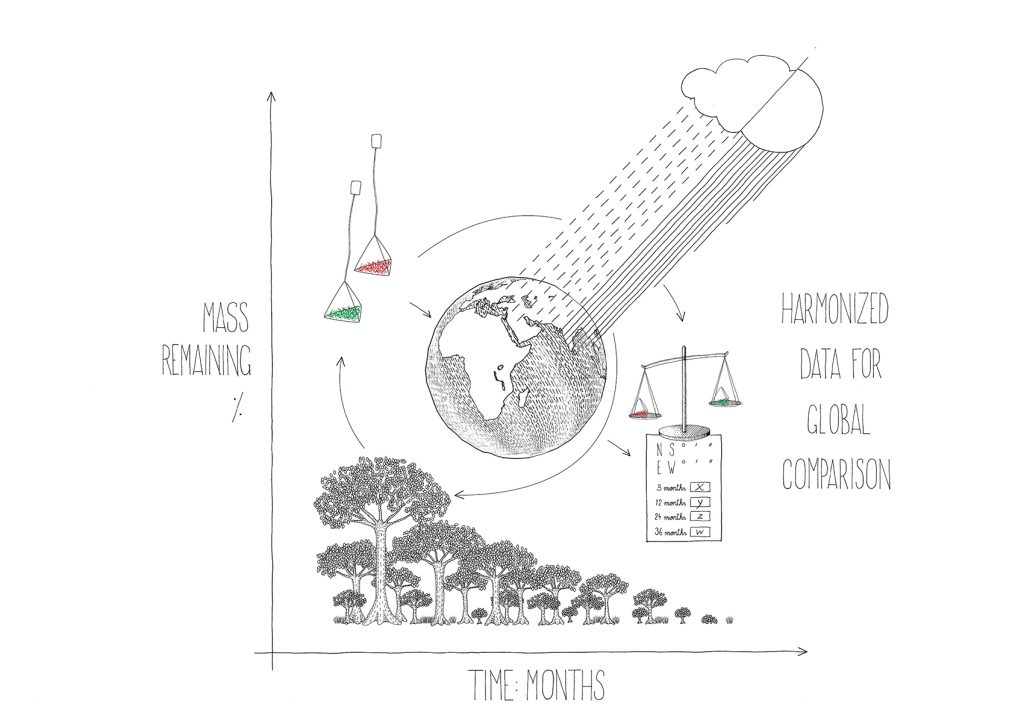Within TeaComposition initiative we aim to study long-term litter carbon dynamics and its key drivers at present and predicted climate scenarios worldwide using a standard protocol. The obtained common metric will provide a strong tool for inter-site comparison within the network as well as within other global networks. Harmonized data on global litter decomposition are of great relevance for scientists, policymakers, and for education of the next generation.
Our task forces are:
Observation/Experiment/Gradient Studies
As a collaborative network, TeaComposition initiative involves high-level experimental and global observation networks making it possible to quantify litter carbon turnover at a high resolution both temporally and spatially, capitalizing on local data to elucidate the abiotic and biotic drivers of decomposition processes relevant for increasing our mechanistic understanding of decomposition processes.
Data Analyses & Synthesis & Education
Within TeaComposition initiative we are endeavor to ensuring the FAIR data practices (https://www.nature.com/articles/sdata201618), which should enhance collaboration, enable synthesis works, and support education and outreach.
Through the cooperation with previous or ongoing large-scale litter decomposition studies (LIDET, CIDET etc.) the collected data on actual litter decomposition (local litter) can be linked to the data on potential litter decomposition (standard litter) relevant for validation of biogeochemical models as well their application for evaluation of driver-impact links.
The TeaComposition initiative links terrestrial to aquatic decomposition process through collaboration with the TeaComposition H2O initiative (http://www.bluecarbonlab.org/teacomposition-h2o/).
We are also aiming to use the "distributed graduate seminars" such the one administrated by National Center for Ecological Analysis and Synthesis (www. nceas.ucsb.edu) to support transcend discipline-bound understanding and knowledge of young scientists on the one hand, and helping processing data from TeaComposition Initiative for common future synthesis work on the other hand.
Modeling & Mapping
The high-resolution decomposition measurements in space and time provide unique data for calibration and validation of biogeochemical models enabling a more accurate quantification of litter decomposition processes.
Policy
An important contribution of TeaComposition initiative lays in providing high-resolution data across spatial and temporal scales relevant for understanding of contribution of litter decomposition to greenhouse gas production. Moreover, linkage of collected leaf litter (tea) decomposition data with wood decomposition studies, such as the 50-study site Wood Stake Decomposition Project, can be also an important source on harmonized litter C turnover data relevant for IPCC reporting.
TeaComposition provides an important Essential Variable (Decomposition Index), which feeds well into one of the GEO BON’s activities, Ecosystem Functions. This essential variable can be linked to the soil diversity data enabling the addressing of potential consequences given through the change in below-ground diversity on ecosystem functions. Hence, obtained data will provide a profound basis for supporting Aichi Biodiversity Targets (https://www.cbd.int/sp/targets/).
Networking of Networks
Litter and soil organic matter decomposition represents one of the most important biogeochemical processes and as such may serve as an intermodal link between the ecological researches disciplines. The TeaComposition initiative provides such a common metric on litter decomposition, which can be used as a common denominator across multidiscipline in ecology. The initiative is already used as a basis for add-on studies such as linkage of N effect with decomposition process or on assessment of nutrient availability and microbial biomass.
Moreover, TeaComposition initiative aims to be a source for information and prime example fostering standardization of analytical procedures, providing overviews of existing research activities, facilitating the closing of data gaps, as well as avoiding duplication of efforts and hence leveraging research to tackle grand scientific challenges that require significant coordinated international efforts.

